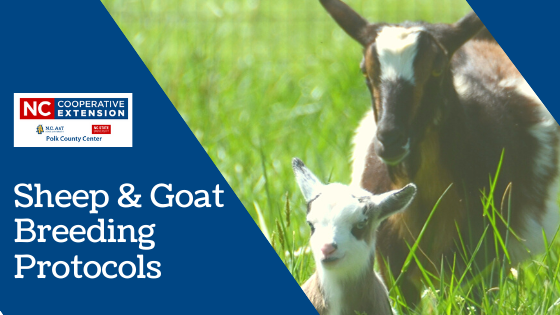Sheep & Goat Breeding Protocols
go.ncsu.edu/readext?675547
en Español / em Português
El inglés es el idioma de control de esta página. En la medida en que haya algún conflicto entre la traducción al inglés y la traducción, el inglés prevalece.
Al hacer clic en el enlace de traducción se activa un servicio de traducción gratuito para convertir la página al español. Al igual que con cualquier traducción por Internet, la conversión no es sensible al contexto y puede que no traduzca el texto en su significado original. NC State Extension no garantiza la exactitud del texto traducido. Por favor, tenga en cuenta que algunas aplicaciones y/o servicios pueden no funcionar como se espera cuando se traducen.
Português
Inglês é o idioma de controle desta página. Na medida que haja algum conflito entre o texto original em Inglês e a tradução, o Inglês prevalece.
Ao clicar no link de tradução, um serviço gratuito de tradução será ativado para converter a página para o Português. Como em qualquer tradução pela internet, a conversão não é sensivel ao contexto e pode não ocorrer a tradução para o significado orginal. O serviço de Extensão da Carolina do Norte (NC State Extension) não garante a exatidão do texto traduzido. Por favor, observe que algumas funções ou serviços podem não funcionar como esperado após a tradução.
English
English is the controlling language of this page. To the extent there is any conflict between the English text and the translation, English controls.
Clicking on the translation link activates a free translation service to convert the page to Spanish. As with any Internet translation, the conversion is not context-sensitive and may not translate the text to its original meaning. NC State Extension does not guarantee the accuracy of the translated text. Please note that some applications and/or services may not function as expected when translated.
Collapse ▲
Sheep and goats are typically short-day breeders, meaning they breed when periods of daylight are shorter. The normal breeding season is usually September through January. Gestation is 5 months for sheep and goats. Does or ewes bred in the fall will usually kid or lamb in the spring of the next year. The profitability of a sheep and goat operation depends on the number of lambs and/or kids raised, weaned, and marketed each year. As the breeding season will be upon us before we realize it, there are a few things that sheep and goat producers can do to ensure that their breeding season is profitable.
Body Condition
Body Condition Score (BCS) should be assessed to make sure that does and ewes are not too thin or too fat. Animals that are too thin or too fat will not cycle into estrus and will not be bred. Ideal body condition is a 5 or 6. Body condition should be maintained during the breeding season and at lambing/kidding. Consider flushing does or ewes that are not in ideal body condition. Flushing (increasing the amount of feed offered) occurs 2-3 weeks before breeding season and provides animals extra nutrition to put on weight prior to breeding. Flushing does or ewes that are in ideal condition will generally not respond. Bucks should also be monitored for body condition. Bucks will lose weight during the breeding season because of the increased physical activity and decreased feed intake.
Why Healthy Hooves Are Important
Hoof trimming, vaccination, and deworming can also affect the breeding season. Animals’ feet should be examined for sores, signs of foot rot or infection, and overgrown hooves. Hooves need to be in good shape during a period of increased activity both for doe/ewe and buck. If any foot rot or sore foot is detected, this needs to be addressed before breeding these animals.
Vaccinations & Deworming
Producers should consider vaccinating twice per year, at the start of the breeding season and 4-6 weeks before lambing or kidding. Bucks should also be vaccinated once per year. Producers can also choose to vaccinate only once per year, which should be done 4-6 weeks before lambing or kidding to ensure immunity is passed to the lamb or kid. Kids/lambs should be vaccinated at 8 weeks old, then a booster at 12 weeks old. CD&T is labeled for goats and is for overeating disease and tetanus, and multivalent clostridial vaccine is labeled for sheep. In areas where Selenium is low, a supplement could also increase fetal development and lessen dystocia problems during lambing and kidding season. Deworming should be done before the breeding season. If producers plan to flush does or ewes, deworming should be done prior to flushing.
Breeding Season
The breeding season should last for at least 40-45 days; this will allow ewes or does to complete two estrous or heat cycles. Estrous cycles are 21 days. The breeding ratio is 1 buck for every 20-30 does or ewes.
If you have any questions about any of these subjects please contact your local veterinarian or County Extension office and we can help talk you through any concerns you may have.




